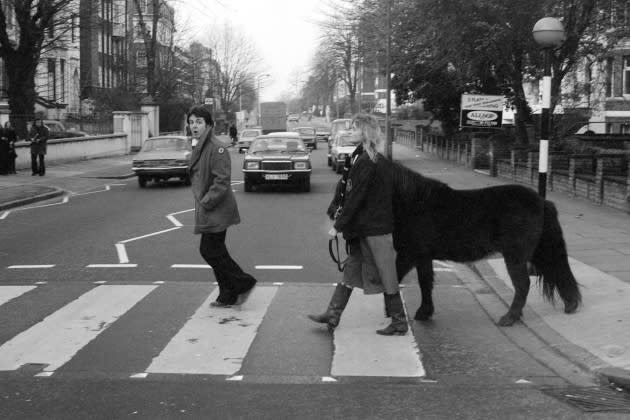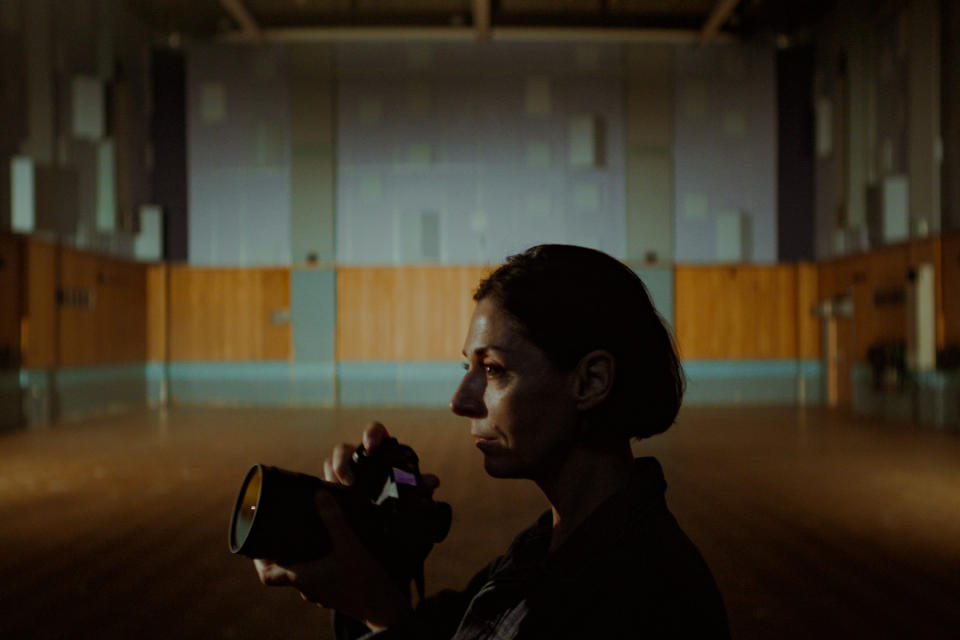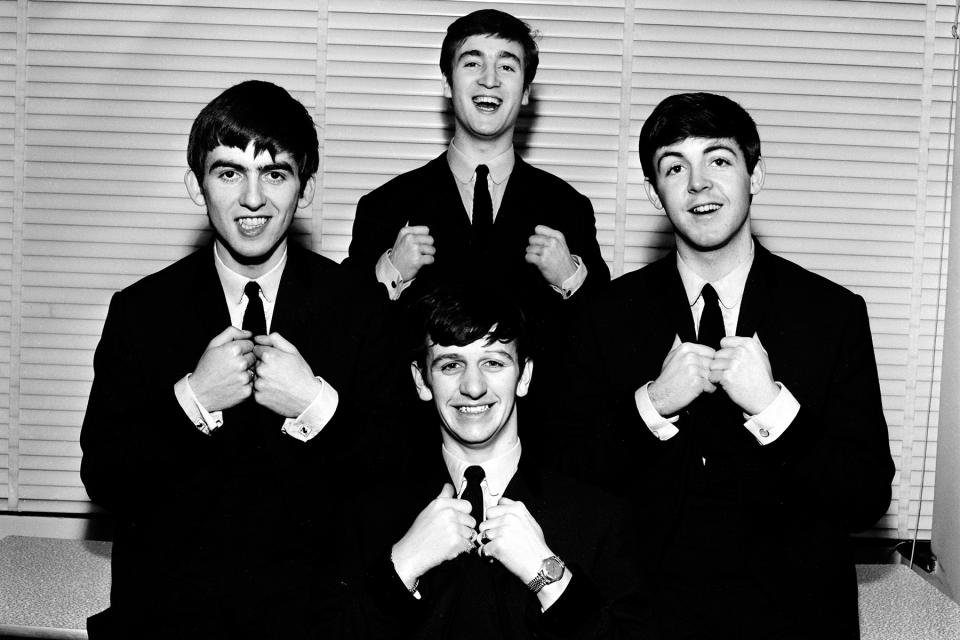Mary McCartney on That Time Her Parents Brought a Pony to Abbey Road
- Oops!Something went wrong.Please try again later.
- Oops!Something went wrong.Please try again later.

If These Walls Could Sing is the long and winding story of Abbey Road Studios. This excellent Disney Original Documentary also happens to be the first film from an acclaimed photographer who knows the studio well: Mary McCartney. Abbey Road has been holy ground for music fans ever since her dad walked barefoot across it with the other Beatles on one of history’s most iconic album covers.
Mary McCartney has known Abbey Road her whole life — the documentary begins with baby photos of her on the studio floor. There are also hilarious pictures from one day when she was a little girl: Her parents Paul and Linda McCartney decided to bring a horse to the studio. They lived right down the street, with all their many animals, so they just brought their Shetland pony Jet to hang out during a session. (Yes, the pony who inspired the hit “Jet.”) As Paul tells Mary, “I don’t think Jet disgraced himself once.”
More from Rolling Stone
QAnon Followers Are Arguing if the Beatles Were Involved in Witchcraft and Child Sacrifice
Was 'Taxman' Inspired by 'Batman'? And Other Burning 'Revolver ' Questions
Elton John, Paul McCartney Talk 'Sacred' Abbey Road Studios in Documentary Trailer
But like many people, she was surprised to find that Abbey Road Studios has such a long history. As she tells Rolling Stone, “When I took on the job, I didn’t know the studio was 90 years old, or that Edward Elgar opened it. I didn’t know Pink Floyd’s Dark Side of the Moon was recorded there. I loved it when I found out Fela Kuti recorded three albums there.”
If These Walls Could Sing goes deep into this history. She interviews legends who have recorded there, from Elton John to Ringo Starr to John Williams, from David Gilmour to Roger Waters. She talks to both Oasis brothers, Noel and Liam Gallagher. (Liam: “It’s a national treasure, innit?”) Jimmy Page tells stories about his early days as a session man, playing on the James Bond movie theme Goldfinger. Shirley Bassey stretched the famous final high note so long, Page watched her faint onto the studio floor. Even the famously reclusive Kate Bush speaks, though off-camera.
Abbey Road is a strange combination: a busy working studio, a place where new music is constantly getting made, but also a shrine for fans who visit so they can walk on the famous zebra crossing outside. (For many Americans, one of the things you might learn in the movie is that British people pronounce it as a “zebb-ra crossing.”) The outside walls are covered in graffiti, dedicated mostly to the Beatles. After Harry Styles played London this summer, the graffiti was full of messages like “All You Need Is Love and Harry Styles.”
Mary McCartney spoke to Rolling Stone about making the documentary and her Abbey Road memories. As she says, “People will feel that they’ve been into Abbey Road — they’ve seen the nooks and crannies.”
For your first documentary, how did you come to tell this story of Abbey Road?
I was approached by John Battsek, who’s an amazing Oscar-winning producer, who I’ve known over the years, but we haven’t worked together. He asked me to direct the Abbey Road documentary. But I said no at first — that was my knee-jerk reaction. Throughout my career, I’ve always felt I need to do everything on my own two feet. And I was a little oversensitive: “Why are they asking me?”
But I realized, “He is such an amazing producer — they’re not just asking me just because of my name.” And I am somebody that knows this place and loves it. When you make a documentary, it has to be about something you care passionately about. So I took on the challenge.

You make the family connection early, with that great photo of you in Abbey Road as a baby.
I wasn’t intending to be in it at all. When I was doing the interviews, I wanted them to be casual — more of a conversation than a formal interview. But even though I said, “Please mention full names, because my voice isn’t going to be in it,” they would say, “Oh, your dad or your mom.” So I felt, “I have to contextualize it.”
One of the best moments is when you show your parents bringing a pony to the studio.
If I had to say one reason that I wanted to do the documentary, it’s because I wanted to use that picture and put it onscreen. I didn’t see that picture until I was at Abbey Road for some work thing. There was a book in reception, a biography of Abbey Road, and that’s where I saw that picture. I’d never seen it, and it just melted my heart.
How does it capture your parents’ personalities for you?
They just thought, “This would be a good thing to do.” And it just happened. It feels natural, right? Even to the viewer, when you see it, It doesn’t seem that odd — just this little pony walking across the road on the lead rope with them.
She loved animals so much. The horses weren’t in London all the time. She had a couple of horses outside the city in a livery. But then she felt, “Oh, I just want to get the horses here.” So they were put in a horse trailer and came to London, in St. John’s Wood, and they were in the garden. She literally rode a horse up and down our street once, and I was mortified. At the time, as a kid, I was like, “Oh, my God, my mom is riding up and down the street in the middle of London.” Now, I’m like, “What a cool chick!”
It’s wild to think of all these animals in London, right by Abbey Road.
Abbey Road is an interesting studio because it is in the middle of everything. St. John’s Wood is quite a residential area. But the building is like a TARDIS [from Doctor Who]. You walk up the steps, you go in, and you go into this crazy adventure.
I live near Abbey Road, so I see people on that sidewalk crossing a lot, making that pilgrimage to have their picture taken and just be there. Because there’s something about Abbey Road where it gives you this feeling, and it gives me that feeling. It feels like a special place, somewhere you want to create. The music that has been made there — the energy somehow does seep into you, or makes you feel inspired.
You have stars like Jimmy Page and Elton John, talking about being session musicians.
Elton John was, at that point, just Reginald Dwight, and he had the smell of fear, because he was a session musician. Like he says, “I had no idea I was going to become Elton John.” He was writing songs, but he made his living doing sessions. You have to go in, playing on somebody else’s track, and you have to just nail it. He talks about playing on “He Ain’t Heavy, He’s My Brother,” by the Hollies — when you just listen to his piano part, you can tell that’s Elton John playing the piano.
Jimmy Page is brilliant — we’ve got that great archive footage of him as a kid, talking about being a session musician. We had the handwritten session sheets, from that time, and we saw that he played guitar on the Shirley Bassey/John Barry Goldfinger theme. So he told us about that — Shirley Bassey held the final note so long, she collapsed.
It’s touching when you interview members of Pink Floyd and Oasis, who aren’t on friendly terms with each other. But Abbey Road is one thing they can agree on.
Even though famously they don’t get along, there feels like a warmth between them, because they wanted to talk about this place. Each person really wanted to be there at Abbey Road, to talk about why it’s such a special place. And it’s bizarre because it’s a building.
But there’s so much innovation and collaboration there. I hadn’t realized with the Beatles recordings, when it started off, how it used to be in the old days — those three-hour block sessions. Musicians would come in. They’d be well-rehearsed, knock it off, have a break, do another song. But then the bands and the engineers started working together, and they say, “Well, how do we do this double-tracking?” And then the engineer would sleep on it and say, “Oh, I’ve had an idea. What if we do this?” Stereo was invented there.
I’m a big chemistry-collaboration person. So it’s not a technical documentary, about the technical side of recording. That’s another documentary someone could make. But for me, I wanted the emotion, and I wanted people to feel the emotion for it, through people telling their stories.
People go to Abbey Road to cross the street. But it’s a surprisingly busy street.
It drives people crazy on the road. Because zebra crossings in England, you have to stop. It’s the one bit of street where the pedestrian rules. So people are crossing all the time to have their picture taken. But local cab drivers and buses are just like, “Ugh!”
But I love it because I like people-watching. When you go there, it doesn’t feel like people just going to have their picture taken — it seems like there’s a real feeling behind it. It feels like a pilgrimage.
It’s beautiful how people meet there and write their messages on the wall.
I think if you love music that much, and you want to go somewhere to congregate, Abbey Road is one of those places. I suppose Graceland would have that — if people want to congregate somewhere to meet and have that moment with each other. But definitely Abbey Road. I often think it’s funny, because when I go by I’m like, “Should I stop?” And I offer to take people’s pictures. I have actually done it a couple of times, and people are like, “No, no — we’re fine.”
But I haven’t been to Graceland. What’s the difference with Graceland?
It’s very formal. There’s a guided tour.
And they’re coming for Elvis, whereas for Abbey Road — obviously the Beatles are the majority, but there’s a lot of other notes when you actually read the wall. There’s so many other reasons that people go there.
I’ve always been really a fan of Jacqueline du Pré, the cellist. When I found out Elgar had opened the studio, then du Pré recorded there with Suvi Raj Grubb, the amazing classical producer, it felt like a full-circle moment, for the story of classical musical there. Her story is so touching. And also the fact that du Pré was able to do that private recording without anybody knowing, just shows the style of Abbey Road. They are there to facilitate the artists, still to this day. And that’s why we call it a home. They create a safe place where people can just go and create.

That Jacqueline du Pré footage is amazing.
She was very hard to record, because when you watch her playing, she jumps around. There’s a beautiful shot of her out in the street in London, looking all fabulous and holding her cello in a case. Such a natural beauty and this smile on her face, but then such depth in her performance. She’s smiling — but it’s heart-wrenching when you hear her play.
Kate Bush is such a crucial voice in the movie. How did she get involved?
That was a surprise, let me tell you. I remember as a kid, when you went into reception at Abbey Road, they used to have a photo gallery of all the people that had recorded there. And I really remember the Kate Bush picture — she had so much drama in her expression, her eye contact. I said, “We have to get Kate Bush.” But I knew she wouldn’t give an interview. And it’s not my style to try and convince anyone. Hard sell is not my style.
But I texted her and said, “Is there any way that I could have your voice? Would you record anything?” We basically were in touch over the whole year, and eventually, she was like, “Oh, I’ve written something.” She sent me the recording. I knew I’d never get an interview with her, but just for her to do that was very meaningful, because she produced her own music there. She directed her own video in Studio Two. She really used that space, and she’s a total rock star. She’s just so cool, because she just does what she wants. She won’t do press, but it’s all come back around for her, because you don’t forget a talent like that.
Best of Rolling Stone

